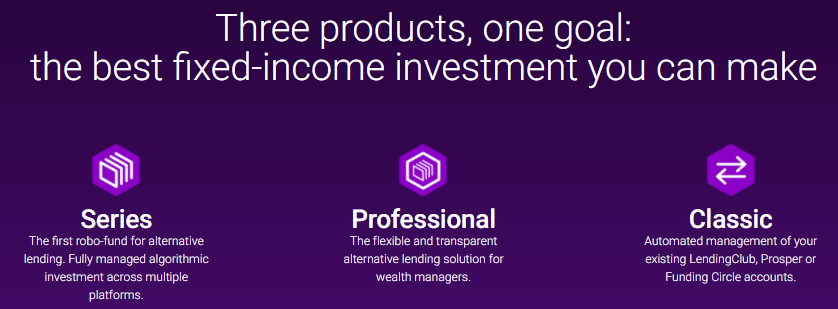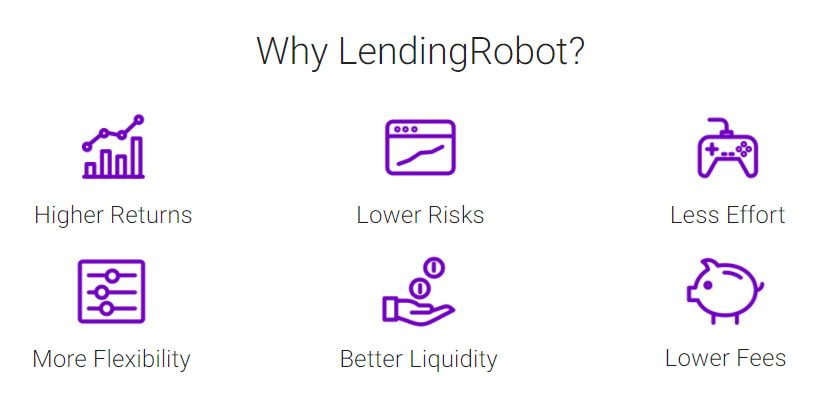Peer-to-Peer lending is the novel application of technology to one of the most ancient of professions: lending.
The premise of lending is simple: people with excess capital lend money to borrowers who need capital. In return, the borrower promises to repay the debt obligation plus interest at a future date. But there is a lot of risk in lending money: any single borrower has the possibility of defaulting on its loan obligations. Based on this, a lender who only makes loans to a limited number of borrowers takes a larger amount of risk for a lower amount of reward. The only way to limit this risk is to make many loans, which will (on average) allow a lender to make a predictable amount of money. Because of the massive amount of money, it takes to be properly diversified, lending (as an asset class) was reserved for banks and the very rich.
Internet based Peer-to-Peer lending originators make the lending process more efficient. In addition to lower fixed costs, each origination platform fractionalizes loans and sells pieces to investors, which opens lending as an asset class to those who may not be ultra-rich. This new setup is being used in many situations, for example, entrepreneurs borrowing capital to expand their business, or a couple obtaining a loan to have their dream wedding.
In the United States, there are four big players in p2p lending: Prosper, Lending Club, Funding Circle, and LendingHome. Each platform facilitates the loan management between the borrowers and lenders, and without these companies, it would be very difficult to coordinate the interaction between borrowers and lenders. Today, this part of the economy has become competitive and to be successful investors need to make sure they have the best tools.
This is where LendingRobot comes in. This platform enables investors to automatically buy p2p lending notes according to specific criteria from the three largest lending providers. Mr Stephen Zentner, LendingRobot’s Product Manager, has answered our questions in detail. If you have been tempted to make the jump from manual p2p investing to automated but you have hesitated, this interview is going to provide you with enough arguments to tip the balance!
LendingRobot a review with Stephen Zentner
In order for peer to peer lending to work a lot of ingredients need to be in place. The basics such as democracy, law, entrepreneurs, the internet have long been in place. What has recently changed to make peer to peer lending as it is today possible?

Peer to Peer lending had the classic chicken-and-egg problem. No bank was incentivized to change how business was being done, and daunting regulation stopped many promising entrepreneurs from making finance more efficient.
Two companies, Lending Club and Prosper marketplace, forged a path for p2p origination platforms in the United States. Each had a rocky relationship with both federal and state regulators while they tried to figure out the best way to apply technology to disrupt an old institution. But once other companies saw what was possible, a bandwagon was formed to bring the concept to a wide assortment of asset loans.
Most investors are familiar with traditional bonds such as those issued by companies quoted on the stock market, they understand how they work. What is the headline difference between traditional bonds and peer to peer lending notes?
There are many differences between bonds and p2p lending notes. If I had to pick the main difference, it would be liquidity. Investors in p2p notes are trading liquidity for yield, as bonds are readily tradable, whereas p2p notes typically must be held to maturity.
Peer to peer lending rates on Prosper, Lending Club and Funding Circle have averaged around 8% in 2015 and about 6% in 2016. Such returns are impressive when compared to the current dividend yields and interest rates on bank accounts. What are the main factors that determine if such returns will be sustainable in the longer term?
When talking about an investment’s yield, an important consideration is how much risk one must take to earn that return. Investors in p2p notes have been able to earn a good return because risk is spread out over many notes. But in the past, investors were limited to one asset class (consumer credit) and one or two lending platforms.
This meant that, while investors were diversified within the platform, investors were susceptible to the risk that one platform may lower their underwriting standards, or that consumer credit itself would perform poorly. To earn the best return for a given amount of risk, it is necessary to spread one’s investment amongst many platforms and types of loans. By doing so, an investor will have a less volatile portfolio without scarifying returns.
Accessing peer to peer lending notes on Prosper, Lending Club and Funding Circle is simple, one needs only create an account, deposit money and “set it and forget it”. In recent years this has become a harder strategy to implement. Why is this the case?
The p2p lending landscape is constantly changing. To stay current and competitive, lending platforms are constantly adjusting their origination criteria and interest rates. Simple strategies and rules-of-thumb that once worked to boost return (like the adage “don’t invest in Nevada”) are outmoded. To perform better than average, investors must stay current with platform underwriting techniques, macroeconomic trends, and with the current p2p origination landscape.
Acquiring the best notes once they are issued is very competitive. There are many interested parties that would like to have the notes with the best return to risk ratio. What combination of assets gives Lending Robot a competitive edge in getting to the most attractive notes before the competition does?
LendingRobot has over seven thousand clients, but only a handful of employees. Our core strength lies in the combination of our machine-learning algorithms, which can quickly line up the best notes that match a client’s risk tolerance, and cloud technology, which allows us to submit all our client’s orders simultaneously. Not only does this combination of technology allow us to be faster than almost everyone else, it also allows us to not play favorites between our own clients, since all clients are quite literally at the front of the line.

Investing is a risky endeavour. Excluding those risks related to peer to peer investing, what are the most important risks that customers need to be aware of when investing via Lending Robot and how does Lending Robot mitigate such risks?
The most dire risk is that an investor’s portfolio is too heavily weighted towards a particular type of loan. For instance, some investors only buy “F” and “G” rated loans, in the hope of obtaining a much higher than average return. What they may not understand is that, by only buying higher interest loans, they are taking on much more risk. If the economy gets shaky, these loans will be the first to default.
Our new method is to let clients only select their risk tolerance, whereby our algorithms create an ideal portfolio of diversified loans just for them. Our algorithms never take time off, never have a bad day, and faithfully apply a consistent strategy throughout time.
Lending Robot has many customers and a limited pool of loans to distribute. How does Lending Robot choose which customers get which loans?
Since Lending Robot uses cloud technology, all client orders are submitted at the same time, which eliminates the need to randomly ration out loans to certain clients.
Even the pooled investment vehicle (i.e. hedge fund) that we manage, LendingRobot Series, has its orders placed on equal footing with each of our other clients. Because of the speed of our system, LendingRobot can secure a 90%+ win rate on orders placed.
What are the costs to the different types of clients for using Lending Robot?
Costs are a flat 0.45% annual fee paid monthly for assets that LendingRobot manages. We charge LendingRobot Series, a hedge fund for accredited investors, a 1% management fee – the lowest in the business.
Are these fees a justifiable investment expense for the investor?
There are many benefits to using a registered investment advisor to manage p2p investments, not just obtaining a better risk/reward ratio (although our research suggests we do provide our clients up to 1.5% higher return than a random selection of similar loans, even after our fees), including secondary market automation, speed of order submission, a more intuitive UI, and better reporting.
For LendingRobot Series members the benefit is even better. Accredited investors only need to open one account with the fund and specify their investment risk and duration. No more juggling between multiple accounts, logins, and tax forms. Because of how the fund is structured, we’re able to provide a lot more value, including building a holistic portfolio that considers cross-platform assets, provide better liquidity, and simplify tax documentation.
To use Lending Robot clients, need to
1. Register on Lending Robot
2. Link their Funding Circle, Lending Club and Prosper accounts
3. Select an investment strategy.
4. Deposit the money in each of these accounts.
and then sit back and let the robot do all the work for them.
How much time does this signing up process take? What can investors do to make it easier?
The actual process of signing up is simple and can take less than ten minutes. Most clients get stuck opening a platform account and transferring funds, because, although p2p lending is over ten years old, there is still an inherent suspicion of any type investment that seems ‘too good to be true’. This suspicion is well served; I always recommend that new investors do their research, check reviews, and talk to professionals (and verify that those professionals are properly registered) before they make any kind of investment.
For accredited investors who are interested in LendingRobot Series, I recommend a careful reading of the fund documents and fact sheet. Accredited investors can also schedule a conference call with myself if they have questions before they apply for membership.

What are the typical actions of investors to “maintain and monitor” their LendingRobot account?
Everything is automated. Once the account is set up, LendingRobot sends periodic emails to keep an investor updated on how their investments are performing. We also have an app that can keep you up to date on the status of each loan in your portfolio.
Do you have advice to those in the younger generations who are preparing for their future careers in fintech?
Even more disruption is coming to the financial industry. I believe it was a PWC report that said that 81% of bank CEOS were worried about the speed of technological change and disruption in finance, and they are correct in worrying.
The good news is that there is a plethora of roles that need to be filled in Intech: data science, compliance, legal, software engineering, business development, marketing, customer service, and more.
But because most rote tasks are automated, those who want to work in fintech must be able to use their brain to think creatively and efficiently. If you’re just considering the field, I recommend sampling courses on data science, digital marketing, and financial concepts on open online courses, like MITs open course ware.
Understand the basics of finance, read widely, and stay curious.
For more information please visit : https://www.lendingrobot.com/
We thank Stephen Zentner for the interview.







